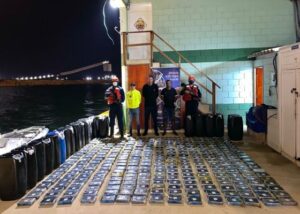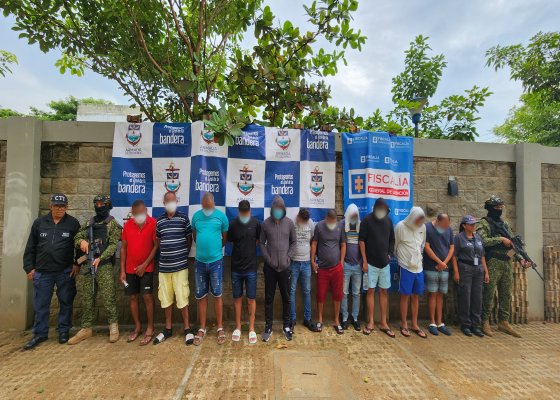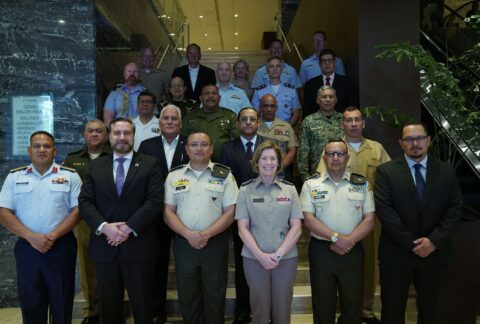On October 12, the Colombian Navy, the Colombian Attorney General’s Office, and the National Police captured 15 narcotraffickers who were the backbone of a criminal network that shipped tons of cocaine hydrochloride from the Colombian Caribbean coast to Central America and Europe, the Colombian Navy said in a statement.
During Operation Octopus (Operación Pulpo), carried out simultaneously in the departments of Riohacha and Santander, authorities found that members of the criminal group would board boats at sea and hide the drugs in the containers, the Attorney General’s Office said in a report.
“The group called themselves Los Containeros,” Colombian Navy Vice Admiral Orlando Grisales Franceschi, chief of Staff of Naval Operations, told Diálogo on October 30. “They replicated the containers’ security seals to avoid suspicion throughout the illicit trafficking logistics chain […], so that the final owner of the merchandise would not be able to tell that the container had been tampered with.”

Narcotraffickers would get the drug from laboratories in Nariño, Cauca, and Magdalena. They would then move it to Cartagena and coordinate its departure in containers to ports in Guatemala, the Dominican Republic, Caribbean countries, the United States, Spain, France, and the United Kingdom, the Attorney General’s Office said.
Among those arrested is alias La R or Rubio, a retired Colombian National Police officer, the top leader of this transnational network. This criminal took advantage of his experience to determine patterns of behavior in Colombia’s main ports in order to contaminate containers, the Navy indicated in its statement.
The Attorney General’s Office said that, during the investigation, authorities seized more than 7.5 tons of cocaine in 12 procedures. In the first phase, authorities arrested and prosecuted 15 members. Thanks to the evidence obtained, 12 of the defendants were sentenced to at least 12 years in prison.
“It’s structural damage that affects drug trafficking,” Vice Adm. Grisales said. “On the financial aspect, we were able to disrupt one of the sources of financing of internal organized armed groups and international mafias in Europe.”
More than 150 personnel took part in Operation Octopus, including prosecutors, members of technical investigation corps, and service members, Vice Adm. Grisales added.
Significant measures
In the last 10 years, the contamination of container ships has become the most common form of drug trafficking to Europe. Every year, 750 million containers are shipped worldwide, but less than 2 percent are inspected, InSight Crime, an international organization that investigates organized crime in Latin America and the Caribbean, indicated. “This gives drug traffickers the opportunity to reach international markets.”
Colombia was not spared the increase in cocaine shipments hidden in containers. On September 15, Colombian anti-narcotics agents seized more than 5 tons of cocaine in three operations carried out in ports of the Colombian Caribbean coast. The drug was hidden in shipments of fruit bound for Europe, Spanish news agency EFE reported.
Another law enforcement operation seized 1.6 tons of cocaine hydrochloride hidden in two containers in Santa Marta on September 7. The drug was bound for Belgium and belonged to the Clan del Golfo criminal group, the Colombian Military Forces’ General Command reported.
Aware of the importance for drug traffickers to maximize their profits, the Colombian Navy made a “strategic vision” change. “We understood years ago that capturing the boat and the truck driver or affecting the group was not substantial,” Vice Adm. Grisales said. “We have to continue fighting narcotrafficking through seizures and interdictions.”
Another significant step the Colombian Navy has been taking against cocaine trafficking is the Orion Naval Campaign, Vice Adm. Grisales added. Since 2018 and during its nine versions, Orion seized more than 1,073 tons of cocaine hydrochloride, the Navy said.
“Orion started with eight countries and eight agencies, today it has 41 countries and 106 agencies working together,” Vice Adm. Grisales said. “To be able to have the information in a timely manner has strengthened us in achieving operational results.”
Working together
As part of the strategy to combat narcotrafficking in both the Pacific Ocean and the Caribbean Sea, the governments of Colombia and the United States continue to collaborate through a bilateral maritime interdiction agreement signed in 1997, Vice Adm. Grisales said.
“This agreement has been very effective. It has allowed us to develop all these operations in a combined manner with them. We have also shared experiences hand in hand with the United States, and with the countries of Central America, to standardize capabilities in the region to be more effective in blocking the use of the sea for illicit activities,” he added.
As part of the cooperation, U.S. Army General Laura J. Richardson, commander of U.S. Southern Command (SOUTHCOM), visited Colombia on two occasions. On her last visit in early September, Gen. Richardson praised Colombian security forces and called Colombia “the United States’ closest security partner.”









